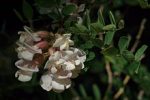 Also known as southwest and desert locust, this deciduous multi branched shrub or small tree is native to areas in southwestern US where it can be an understory tree or grow in pure stands in forest openings. It is a member of the pea family, Fabaceae, that also include mimosa, lupines, and beans. Plants grow 10-25′ tall and have 4-6″ long pinnate leaves that are blue-green and divided into 7-15 lance-shaped leaflets up to 1.5″ long. A pair of sharp spines are located on each side of the leaf scars. From spring to early summer fragrant white to pink pea-like flowers appear in dense drooping racemes 2-4″ long and give way to bean-like fruits that persist into winter. The plants tend to root sprout and may form dense thickets and are very drought tolerant and therefore useful in water saving gardens The genus name, Robinia, honors Jean Robin (1550-1629) the gardener of Kings Henry IV and Louis XIII of France. The specific epithet, neomexicana, is the Latinized form of New Mexico, one of the locations where the plant is found.
Also known as southwest and desert locust, this deciduous multi branched shrub or small tree is native to areas in southwestern US where it can be an understory tree or grow in pure stands in forest openings. It is a member of the pea family, Fabaceae, that also include mimosa, lupines, and beans. Plants grow 10-25′ tall and have 4-6″ long pinnate leaves that are blue-green and divided into 7-15 lance-shaped leaflets up to 1.5″ long. A pair of sharp spines are located on each side of the leaf scars. From spring to early summer fragrant white to pink pea-like flowers appear in dense drooping racemes 2-4″ long and give way to bean-like fruits that persist into winter. The plants tend to root sprout and may form dense thickets and are very drought tolerant and therefore useful in water saving gardens The genus name, Robinia, honors Jean Robin (1550-1629) the gardener of Kings Henry IV and Louis XIII of France. The specific epithet, neomexicana, is the Latinized form of New Mexico, one of the locations where the plant is found.
Type: Deciduous flowering shrub or small tree
Outstanding Feature: Flowers; drought tolerance
Form: Rounded
Growth Rate: Rapid
Bloom: Dense racemes 2-4″ long of white to pink pea-like flowers from spring to early summer
Size: 10-15′ H
Light:Full sun to part shade
Soil: Average, dry to moist, well-drained
Hardiness: Zones 5-10
Care: Low maintenance
Pests and Diseases: None of significance
Propagation: Seeds (may need soaking in hot water for 24 hours to soften seed coat)
Photo Credit: Wikipedia